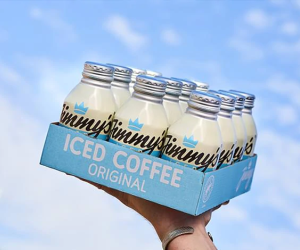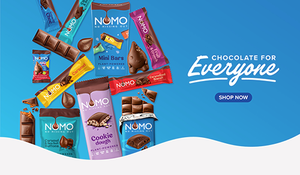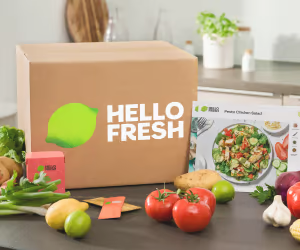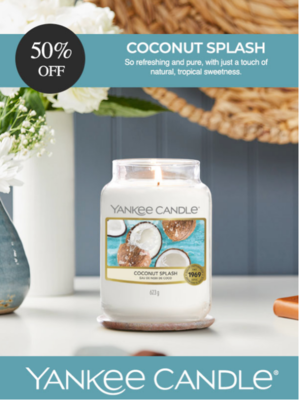Keep homemade ice cream smooth and scoopable with expert storage tips, ideas for the best containers, and freezer tricks to prevent ice crystals for the best texture and flavour.
You’ve Done all the Work — Now Let’s Store it Correctly
You’ve put all your creativity into making the perfect homemade ice cream — you measured, mixed, blended and churned it with care. You proudly tucked it away in the freezer, excited for that satisfying scoop later.
And then… a day or two goes by.
You pull it out, open the lid — and instead of a smooth, creamy masterpiece, you’re met with crunchy crystals and grainy texture. What happened?!
We’ve been there. And we know the feeling. But don’t worry — it’s totally avoidable.
In this guide, we’re sharing exactly how to store homemade ice cream properly — whether it’s no-churn, Creami, vegan, or dairy-based — so your frozen treats stay flavourful and fabulous from scoop one to the last spoonful.
Learn the best ways to store your homemade ice cream to prevent ice crystals, preserve flavour, and keep that dreamy texture intact to keep it scoopable, smooth, and delicious — every time.
Whether you’re a no-churn newbie or a Creami convert, these tips will help your frozen creations last longer — and taste better.
In This Article, We’ll Share:
- ✅ Why Homemade Ice Cream Needs Special Storage
- ✅ When & How to Store It for Maximum Scoopability
- ✅ Avoiding Common Mistakes (like freezer burn!)
- ✅ Not All Ice Creams Are Created Equal – What That Means for Storage
- ✅ Quick Chart: Shelf Life + Defrosting Tips by Ice Cream Type
- ✅ Best Containers for Preserving Flavour & Texture
- ✅ Our Top Amazon Picks: Tried & Tested Ice Cream Containers
- ✅ FAQs on Texture, Refreezing & More
- ✅ Final Scoop Wrap-Up
Why Homemade Ice Cream Deserves a Little Extra Love
Store-bought ice cream has stabilisers, gums, and a few too many mystery ingredients that help it stay soft and scoopable for weeks. Homemade ice cream? None of the above. That’s actually a good thing.
Making your own means:
- ✅ You know exactly what goes in — no additives or preservatives
- ✅ It’s often cheaper, especially in larger batches
- ✅ You can customise flavours, bases, and dietary needs
- ✅ It’s fun, creative, and (let’s face it) pretty satisfying
But where homemade means fewer stabilisers, this makes it a little more delicate, and it needs a bit of extra love in storage to protect all that goodness you worked so hard to create.
Homemade ice cream is more prone to:
- Ice crystals
- Separation (especially with lower-fat or dairy-free recipes)
- Absorbing odours from your freezer
- Becoming rock solid if not stored right
💡 Did You Know?
Homemade ice cream should ideally be enjoyed within 1–2 weeks of freezing for peak flavour and texture. After that, it may lose creaminess — or take on a stale freezer taste.
When & How to Store It for Best Results
✅ Right After Churning:
- Transfer to a shallow container immediately after churning.
- Press baking paper or cling film directly onto the surface to minimise air contact.
- Seal tightly and freeze for at least 4 hours to set fully.
✅ From the Creami or After a Re-Spin:
- If you’re not eating it right away, level the top and re-cover it with the lid or cling film before refreezing.
- Avoid storing in the Ninja Creami tubs long-term — use a separate freezer-safe tub.
💡 Did You Know?
Re-spun Creami ice cream should be eaten within 1–2 days for the smoothest texture — the longer it sits, the more icy it can become!
Avoid These Common Ice Cream Storage Mistakes
❌ Storing in a deep tub — it takes longer to freeze, encouraging larger ice crystals
❌ Freezing in warm spots (like the door or near a vent)
❌ Using containers not designed for freezing (some plastics crack or leach)
❌ Letting ice cream sit uncovered between scoops
❌ Refreezing after it’s half-melted — this can ruin texture permanently
Not All Ice Creams Are Created Equal
When it comes to homemade ice cream, one size definitely doesn’t fit all.
The base you use — whether dairy, non-dairy, low-sugar, or keto — plays a huge role in how your frozen creation behaves in the freezer.
- Dairy-based ice creams tend to stay creamier for longer thanks to their natural fat content.
- Non-dairy or vegan recipes (like those made with almond, oat, or coconut milk) can freeze harder and become icier, especially if they’re lower in fat.
- Low-sugar and keto bases often skip stabilisers or sugar alcohols, meaning they may separate or crystallise if not stored with care.
That’s why storing each type properly — in the right container, for the right amount of time — makes all the difference between “creamy & dreamy” or “a frosty flop.”
👉 Check the chart below for shelf life tips and storage recommendations based on the type of ice cream you’re making.
Quick Chart – Homemade Ice Cream Shelf Life & Storage Tips
| Type | Best Storage Container | Fridge Life | Freezer Life | Defrost Time |
|---|---|---|---|---|
| No-Churn (Dairy) | Plastic or metal tub | 1–2 days | 1–2 weeks | 5–10 mins at room temp |
| Creami Re-Spin | Different container | 1 day max | 2–5 days | 10 mins then re-spin |
| Vegan/Keto Bases | Vacuum-seal or glass | 1–2 days | 1 week (max) | 15–20 mins at room temp |
The Best Containers for Homemade Ice Cream
You’ve nailed the recipe — now to make sure it stays as smooth and scoopable as it deserves to be. The container you choose can make or break your ice cream’s texture, so it’s worth picking the right one.
Here’s what to look for (and what to avoid) when storing your homemade frozen treats.
✅ What to Look For:
| Feature | Why It Matters |
|---|---|
| Flat, shallow shape | Faster freezing = fewer crystals |
| Tight-fitting lid | Prevents air + freezer burn |
| Freezer-safe material | Avoids cracking or warping |
| Opaque or dark | Helps block light and preserve flavour |
| Stackable | Saves space and keeps the freezer tidy |
Our Top Picks for Ice Cream Storage Containers
Looking for a storage solution that works for your flavour-packed frozen creations? These tried-and-tested containers offer airtight sealing, stackability, and reliable freezer performance — plus they match up with our favourites from Ice Cream Storage Solutions – Essential Tips To Keep Your Homemade Ice Cream Fresh!.
Whether you’re storing rich dairy blends or delicate non-dairy options, these freezer-friendly containers have you (and your dessert) covered:
| Container | Key Features | Why We Love It |
|---|---|---|
| ACME 4 Litre Ice Cream Tubs with Lids | Large capacity, food-safe plastic, stackable | Great for bulk freezing and commercial-style prep |
| We Can Source It Ltd 2 Litre Tubs | Dishwasher safe, tight snap-on lids, reusable | Perfect for everyday home batching or smaller freezers |
| Lakeland Stack-a-Boxes (400ml) | BPA-free, stackable, freezer + microwave safe | Ideal for portioning different flavours or dietary types |
| Sistema Accents Collection Containers | Colour-coded lids, BPA-free, 1L capacity | Useful for flavour labelling or dietary separation |
| Insulated Silicone-Lined Ice Cream Containers (2-Pack) | Double-walled, freezer-safe, reusable | Maintains temp longer — great for serving or gifting |
| Sistema Rectangle Stackable Leak-Proof Containers | Leak-proof, stackable, rectangular design | Flat base = faster freezing + better texture retention |
Disclosure: This post contains affiliate links, which means that we may receive a commission if you make a purchase using these links. As an Amazon Associate, we earn from qualifying purchases.
💡 Did You Know?
Plastic containers tend to insulate slightly better and reduce freezer burn, while glass freezes faster but can increase the risk of texture issues unless you’re vacuum-sealing or consuming quickly.
📌 FAQs – Ice Cream Storage & Texture
❓ Why does my homemade ice cream go icy after a few days?
Likely caused by air exposure. Always press cling film or baking paper onto the surface before sealing.
❓ Can I use glass jars or mason jars?
Yes, but only short-term. They’re not ideal for longer freezing — especially with water-rich bases.
❓ How do I make ice cream scoopable straight from the freezer?
Add a tablespoon of alcohol (like vodka or rum) to the base — it lowers the freezing point without changing the taste.
❓ Is it okay to re-freeze ice cream after scooping?
Technically, yes, but the texture will degrade. For best results, the ideal would be to portion before freezing if you don’t plan to eat it all at once (although we know sometimes once you start, you can’t stop!).
❄️ Ice Cream’s Made — Now Let’s Make It Last!
You’ve crafted something delicious — now let’s keep it that way! Discover more expert tips on ice cream storage, container reviews, and scoop-saving tricks.
Have your own freezer fix or favourite container? Drop us your ideas and tips in the comments or tag us on social — we’d love to know your genius ideas and hacks!
The Final Scoop
Storing your homemade ice cream properly is just as important as nailing the recipe itself. Skip the guesswork, protect your flavours, and keep things scoopable by using smart containers, airtight covers, and a few simple habits.
We hope you’ve enjoyed our article – How To Store Homemade Ice Cream For The Best Texture & Flavour – and that it helps you keep your frozen creations just as fabulous on Day 5 as they were on Day 1.
If you’ve discovered a tip or product that works wonders for your freezer stash, leave us a comment — we’d love to include your hacks in future updates!
Stay connected for more ice cream intel, no-churn recipes, and creative inspiration. Tag your scoops and freezer wins on Pinterest or Instagram — we love seeing your creations.
💬 Got a go-to container you love? Or a clever trick to keep ice cream scoopable? Let us know in the comments — or tag us on Pinterest and Instagram!
Disclosure: This post contains affiliate links. If you click on these links and make a purchase, we may earn a small commission at no additional cost to you. This helps support our website and allows us to continue creating content. Thank you for your support!











































Hey there,
I’ve gathered these questions just by reading your article;
Why does homemade ice cream tend to develop ice crystals more quickly than store bought varieties?
What types of containers are best for preserving the texture and flavor of homemade ice cream?
My discussion for you about topic;
Storing homemade ice cream properly is just as important as making it. Unlike store bought brands that contain stabilizers and additives to maintain texture, homemade versions are more natural and need extra care. If you’ve ever opened a batch only to find it rock solid or icy, you’re not alone and it doesn’t mean you did anything wrong in the recipe.
It just means your storage method needs a tweak. Using airtight containers, covering the surface with wax paper or plastic wrap, and placing it deep in the freezer away from the door can make a big difference. These small steps help lock in creaminess and flavor, so all your hard work in the kitchen doesn’t go to waste.
Hi Linda — thank you for such a thoughtful comment and for raising those excellent questions!
You’re absolutely right — homemade ice cream is more prone to ice crystal formation because it doesn’t contain the commercial stabilisers and emulsifiers you’ll often find in store-bought brands. While that means our homemade scoops are more natural (and in my opinion, tastier!), it also means they’re a little more delicate when it comes to storage.
For your first question: ice crystals form more quickly when air and fluctuating temperatures get to the ice cream.
Store-bought tubs are often flash-frozen at extremely low temps and sealed with industrial equipment, which slows down crystal growth. At home, our freezers can’t match that speed, so a tight seal and stable temperature are key.
For your second: I’ve had the best results with shallow, airtight, freezer-safe containers — ideally with a tight-fitting lid and a bit of headroom for expansion. If I’m storing a batch for more than a few days, I also press a layer of baking parchment or cling film directly onto the surface before sealing the lid, as you mentioned — it’s such a simple step, but it really does help.
I couldn’t agree more with your point about placing it deep in the freezer away from the door — that stable temperature makes a huge difference to keeping it creamy.
Thank you again for sharing your insights — it’s always great to swap tips with fellow ice cream enthusiasts!
Appreciate you dropping by,
All the best
Cherie